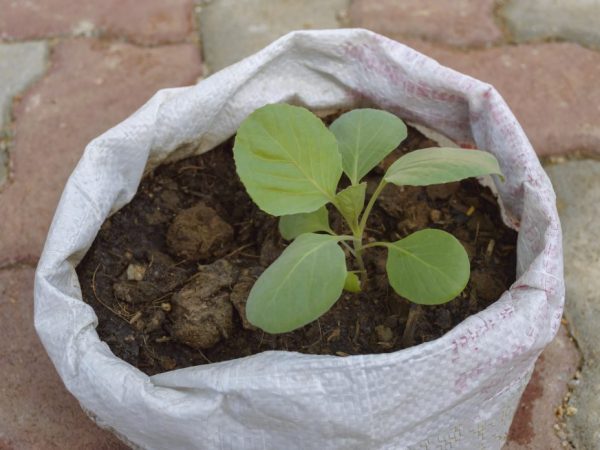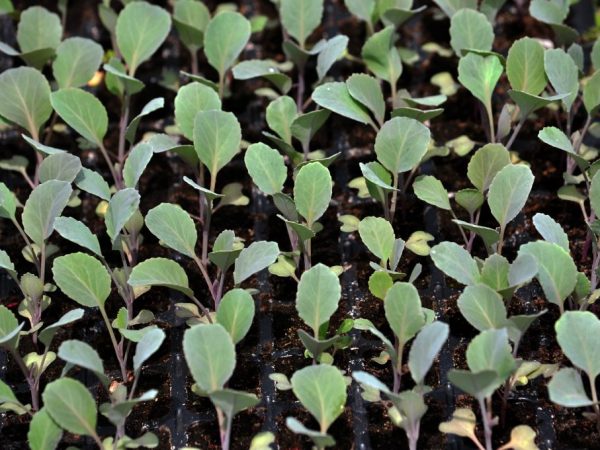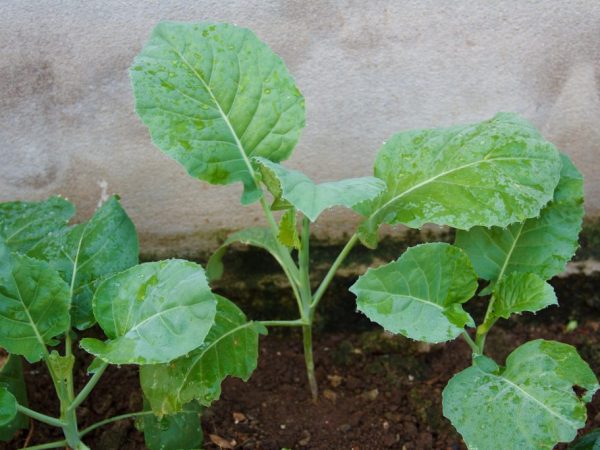Fertilizing cabbage seedlings
Fertilizing cabbage seedlings is needed to increase plant growth. To do this, use manure, ash and chicken droppings or mineral fertilizers: potash, phosphorus, nitrogen.

Fertilizing cabbage seedlings
First feeding of cabbage
The first time fertilizers are applied after planting seeds in the ground. During this period, the leaves and stems begin to gain strength. To feed cabbage seedlings, nitrogen fertilizers are used.
Even before planting, the pits are filled with a special fertilizer mixture. For cooking you will need:
- 600 g of compost, instead of which you can take the same amount of humus;
- 2 tsp superphosphate or nitrophosphate;
- 2-3 st. l. wood ash.
The prepared mixture is added to each well. After this procedure, in greenhouses or open ground, the plant develops more actively and gives a healthy harvest.
Top dressing after picking
After picking, cabbage seedlings are fed with ammonia solution. To do this, take 4 g of ammonium nitrate, 2 g of potassium chloride and 5 g of superphosphate. All components are mixed in 1 liter of water. This is enough for 3-4 bushes.
The second feeding is carried out 12-15 days after the first. It is made on the basis of 3-5 g of ammonium nitrate. It is diluted in 1 liter of water. The bushes are watered immediately after preparation of the solution.
Fertilizer for cabbage seedlings is applied for the third time no later than 10 days before planting. The composition of the fertilizer is similar to the first feed. Take 6 g of ammonium nitrate, 4 g of potassium chloride, 15 g of superphosphate. All components are mixed and diluted in 2 liters of water, allowed to brew for 2-3 hours, after which they are introduced into prepared wells.
Complex fertilizers
Nitrogen fertilization of cabbage seedlings has a positive effect on plant growth, but it is better to use complex fertilizers that combine organic and mineral components.
Fertilizers suitable for early cabbage:
- 1 liter of mullein, diluted in 15 liters of water;
- 1.5 boxes of ammonium nitrate mixed with 12 liters of water;
- 25 g of potassium diluted in 15 liters of water;
- a mixture of 250 g of ash and 65 g of superphosphate, diluted in 15 liters of water;
- a solution of 15 g of potassium chloride, 15 g of urea and 25 g of superphosphate, diluted in 15 liters of water.
These fertilizers must be injected under each seedling bush, 500 ml. If the pH is acidic in the garden, it is imperative to introduce fertilizers based on chalk, quenched wood ash. The norm is 200 ml per 1 sq. m.
Mineral dressing

We fertilize necessarily
The best remedy is nitrophoska. This is a complex of phosphorus, potash and nitrogen fertilizers. It increases yields by 4 tons per hectare. Introduce 15 kg per hectare.
Phosphoric
Phosphate fertilizers are important for good growth and full development. They are suitable for different varieties of vegetables: both early and late.
Bone meal is an indispensable additive for the development and growth of plantings. Phosphorus predominates in its composition. Bone meal is rich in phosphorus and many other biologically active trace elements. It is advisable to add it to the holes 3 weeks before planting the sprouts.
Another effective phosphorus fertilizer is diammophos (ammonium hydrogen phosphate). This dressing does not contain nitrates. Such fertilizer for seedlings is applied to the soil immediately before planting. It will take 10-15 g per 1 sq. m.
Another fertilizer is superphosphate. It contains useful trace elements:
- sulfur;
- monocalcium phosphate;
- magnesium;
- phosphoric acid.
Superphosphate is prepared as follows: 100-150 g of this fertilizer are diluted in 15 liters of water. It is intended for good plant growth and for increased yields.
Some beneficial trace minerals are poorly absorbed by the plant. To prevent this from happening, top dressing is applied in the fall. During the winter, it enriches the topsoil, which prepares the soil for planting seedlings.
Potash
Cabbage seedlings need potassium supplements when heads of cabbage appear. Such feeding is carried out 15 days after planting seedlings in open ground.
One of the recipes:
- Take 10 g of potassium, 20 g of superphosphate, 10 g of urea.
- Mix with a bucket of water.
- Let it brew for a day.
- Apply under each seedling bush in the amount of 0.5 liters of solution.
Potash fertilizers are recommended to be applied 20 days before harvest. This is suitable for late varieties of cabbage. You will need 30 g of sulfuric potassium and a bucket of water. Mix everything and add 200 ml under each bush.
Nitrogen
Nitrogen is found both in organic matter and in mineral components. It increases the growth of cabbage seedlings, if used in combination with such means:
- "Solution";
- "Kristalon";
- "Kemira".
One of the feeding options - 30 g of azofoska is mixed with 15 g of one of the products. To this add 0.5 l of liquid mullein. The rootstock is applied 20 days after the first shoots appear on the seedlings.
Folk remedies

We prepare fertilizers ourselves
For early cabbage, not only store-bought fertilizers are suitable. She responds well to mixtures prepared according to folk recipes.
It is very good to feed cabbage seedlings with boric acid. To prepare this solution, you need 1 tsp. boric acid dilute in 1 tbsp. boiling water and stir. The resulting concentrate is diluted in 10 liters of warm water, after which the plant is sprayed. Spraying is best done in mid-July to stimulate good plant growth.
Other folk remedies:
- Baking soda. For preparation, 30 g of soda is diluted in a bucket of water. After that, the plant is watered with this solution in an amount of 100 ml per bush.
- Young nettles. To do this, nettle leaves are tightly filled into a bowl, filled with water and left for 4-5 days. After the broth is mixed with water in a ratio of 1 to 10 and then watered.
- Ammonia. For a solution of ammonia, 4 tbsp are needed. l. solution. They are added to a bucket of water and mixed. This solution is poured under the root (150-200 ml each).
Often, the plant is fed with banana infusion. For its preparation, a banana peel is placed in a container to the top and poured with water. After insisting, after 4-5 days, the infusion is filtered through gauze and the beds are watered with it.
Feeding with urea
Now urea is extracted from fish protein and mammalian protein. This fertilizer is used to accelerate the growth and increase the vigor of plants.
To make a top dressing from urea, take 40 g of the substance and dilute it in a bucket of water. Water 400-500 ml under each bush.
Mullein feeding
In order for the head of cabbage to grow quickly, complex fertilizers are used, which include mullein. To prepare the solution, a small part of the manure is mixed with 6 parts of water and left to infuse open for 3 days. After that, it is diluted with another 6 parts of water.
Before watering, add 40 g of superphosphate to the bucket. Approximately 2 liters of solution are applied under each bush.
Feeding with yeast
It is necessary to feed cabbage seedlings with yeast. Yeast protects the plant from many diseases and promotes the rapid growth of the root system. They contain a large amount of useful trace elements, amino acids and vitamins.
Yeast, despite its good qualities, lowers the amount of calcium and potassium in the soil. Because of this, top dressing is applied along with ash or crushed egg shells.
Yeast top dressing is easy to prepare. To do this, take 1.5 liters of warm water, but not boiling water, then pour 250 g or 1.5 tsp into the water. yeast. The resulting mixture is stirred and left to infuse for 3 hours. After the yeast is well dissolved, add 10 liters of water, and then proceed to watering. Fertilizer is applied at 200-300 ml under the root of the plant.
Conclusion
For the active growth of cauliflower and white cabbage, the introduction of fertilizers is carried out in the late evening. Each type of feeding improves growth, prevents the development of diseases, and improves the quality of the soil. Such procedures make it easier to grow the crop, making it strong and healthy.


